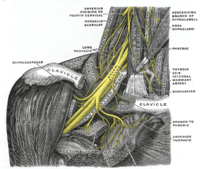
Photo from wikipedia
Background and Aims: Axillary brachial plexus block is commonly performed for surgeries on the hand and forearm. However, there are very few studies on the use of magnesium sulphate in… Click to show full abstract
Background and Aims: Axillary brachial plexus block is commonly performed for surgeries on the hand and forearm. However, there are very few studies on the use of magnesium sulphate in axillary brachial plexus block and, hence, the study was designed to evaluate magnesium as an adjuvant to ropivacaine-induced axillary block with respect to onset and duration of sensorimotor block and postoperative analgesia. Methods: Sixty patients of the American Society of Anesthesiologists (ASA) physical status I and II, undergoing surgeries on the hand and forearm were randomly recruited to receive ultrasound-guided axillary block with either 150 mg magnesium sulphate or 1 mL normal saline added to 0.5% ropivacaine. The primary outcome measure was to compare block characteristics including postoperative analgesia and the secondary outcome was to compare the use of rescue analgesia and the side-effect profile. Data were statistically analysed using Statistical Package for Social Sciences (SPSS version 21.0). Categorical variables were compared using the Chi-square test or Fisher's exact probability test; continuous variables compared using unpaired t-test or Mann-Whitney U test. Results: Onset of sensory (9.93 ± 1.31 vs 8.83 ± 1.12 min) as well as motor block (13.37 ± 1.63 vs 11.57 ± 1.30 min) was significantly hastened with addition of magnesium to ropivacaine (p < 0.001) and so was the duration (sensory 386.60 ± 18.26 vs 526.37 ± 27.43, motor 323.73 ± 15.17 vs 436.97 ± 18.99 min) (p < 0.001) and postoperative analgesia (425 ± 21.39 vs 572.83 ± 32.04 min) (p < 0.001) which reflected in decreased requirement of rescue analgesic and total postoperative analgesic dosage. Conclusions: Magnesium is an effective and safe adjuvant to local anaesthetics and improves all characteristics of axillary brachial plexus block along with postoperative analgesia.
Journal Title: Indian Journal of Anaesthesia
Year Published: 2020
Link to full text (if available)
Share on Social Media: Sign Up to like & get
recommendations!